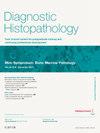英国国家免疫细胞化学和原位杂交外部质量评估计划(UK NEQAS ICC & ISH) her2低EQA计划:结果和影响成功染色的因素综述
引用次数: 0
摘要
英国国家免疫细胞化学和原位杂交质量评估计划(UK NEQAS ICC &;(ISH)在2023年初。我们报告在其运作的前18个月产生的结果(7次评估运行,527份提交)。在第一轮比赛中,54.5%的参与者的提交失败了。失败的主要原因是在这次和所有随后的评估中染色弱,提交失败。在前三次评估运行中,故障率继续高于50%;从第4次运行开始,并在随后的所有运行中持续运行,故障率下降到第7次运行时约为20%。这一变化与任何可获得数据的方法学参数(一抗、抗原检索、检测系统或自动化平台)无关。总的来说,有2258个核心样本可用,99.2%的样本预期为阴性(her20),显示染色与该类别一致;71.预期染色为HER2 1+的患者中有%和预期染色为HER2 2+的患者中有60.5%被评估为显示正确的染色水平。染色弱于预期的岩心样本共有531个(23.5%),染色强于预期的岩心样本有52个(2.3%)。4B5克隆(Ventana)是最常用的一抗,391例(87.3%)的提交使用该克隆;其中,275人(70.3%)通过了考试。相比之下,使用CB11克隆(甲骨文,徕卡)的25个提交中没有一个(5.6%)获得通过。本文章由计算机程序翻译,如有差异,请以英文原文为准。
The UK National External Quality Assessment Scheme for Immunocytochemistry and In-Situ Hybridisation (UK NEQAS ICC & ISH) HER2-low EQA programme: a review of results and factors influencing successful staining
An EQA specifically designed for the assessment of immunohistochemical stain quality in the area of HER2-low testing was established by UK National Quality Assessment Scheme for Immunocytochemistry and In-Situ Hybridsiation (UK NEQAS ICC & ISH) at the beginning of 2023. We report on the results produced during the first 18-months of its operation (7 assessment runs, 527 submissions). At the first run 54.5% of participants’ submissions failed. The principal reason for failure was weak staining at this and at all subsequent assessments where submissions failed. The fail-rate continued to be above 50% for the first three assessment runs; beginning at run 4 and continuing in all following runs, the fail-rate declined such that it was around 20% at run 7. This change was not associated with any methodological parameter on which data was available (primary antibody, antigen retrieval, detection system or automation platform). Overall, 2258 core samples were available, 99.2% of all samples expected to be negative (HER2 0) showed staining concordant with that category; 71.% of those expected to stain as HER2 1+ and 60.5% of those expected to stain as HER2 2+ were assessed as showing the correct level of staining. Core samples showing weaker than expected staining totalled 531 (23.5%) while 52 (2.3%) showed stronger staining than expected. The 4B5 clone (Ventana) was the most commonly used primary antibody with 391 (87.3%) of submissions using this clone; of which, 275 (70.3%) passed. In contrast none of the 25 (5.6%) submissions that used the CB11 clone (Oracle, Leica) achieved a pass.
求助全文
通过发布文献求助,成功后即可免费获取论文全文。
去求助
来源期刊

Diagnostic Histopathology
Medicine-Pathology and Forensic Medicine
CiteScore
1.30
自引率
0.00%
发文量
64
期刊介绍:
This monthly review journal aims to provide the practising diagnostic pathologist and trainee pathologist with up-to-date reviews on histopathology and cytology and related technical advances. Each issue contains invited articles on a variety of topics from experts in the field and includes a mini-symposium exploring one subject in greater depth. Articles consist of system-based, disease-based reviews and advances in technology. They update the readers on day-to-day diagnostic work and keep them informed of important new developments. An additional feature is the short section devoted to hypotheses; these have been refereed. There is also a correspondence section.
 求助内容:
求助内容: 应助结果提醒方式:
应助结果提醒方式:


